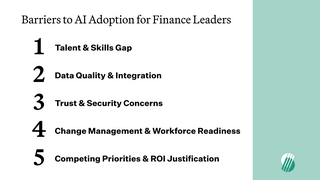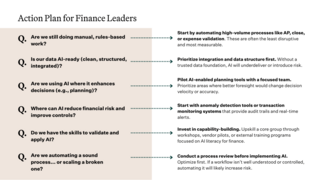Growth Insights| July 2025
Rethinking the Finance Function: What AI Means for Strategy, Systems, and Teams
As a firm that partners with a broad range of companies – but especially software, data, and consumer internet businesses – we’ve seen how the rapid development and adoption of AI has challenged leaders across functions. Finance in particular has experienced a sea change – the role of the CFO was already evolving, and for many, AI has only accelerated the transition from traditional financial stewards into strategic operators, tech adopters, and catalysts of change inside of their organizations.
To help leaders take advantage of this moment, we interviewed prominent finance experts from our network: Chris Maclin, CEO of Spectrum portfolio company Empyrean; Paul Byrne, former CEO of Trintech, independent board member, and advisor; Lee Kirkpatrick, former CFO of Twilio, independent board member, and advisor; and Spectrum’s own CFO, Brian Regan. This article lays out key elements of this shift, along with its inherent challenges and opportunities:
- As finance leaders strive to drive efficiencies and play more strategic and catalytic roles, they must carefully balance these goals. The CFO Hierarchy of Imperatives, outlined in the next section, illustrates how AI can help scale impact at each level.
- Our research shows that adoption of automation and AI is strongest in rules-based, high-volume tasks (e.g., AP processing, financial close) but less mature in areas requiring nuanced judgment (e.g., FP&A, audit, compliance).
- For finance leaders broadly, as well as within Spectrum’s portfolio, barriers to adoption include lack of technical expertise, poor data quality, security concerns, change management challenges, and competition for resources in lean organizations.
- Successful implementation of automation and AI requires a deliberate approach: investing in data readiness, upskilling teams, starting with clear, measurable use cases, and ensuring auditability and governance.
- The opportunity: Finance leaders can use automation and AI to reduce friction at the lower layers of responsibility and unlock capacity. But just as AI-driven tech can empower finance leaders, it will also challenge them to take on a more nuanced role in their organization.

Experts clockwise from top left: Empyrean Solutions CEO Chris Maclin; Paul Byrne, advisor; Spectrum CFO Brian Regan; Lee Kirkpatrick, advisor.
Whether you’re a finance leader yourself, or are part of a company designing solutions for the finance function, this article should help you understand and take advantage of this moment.
“We’re no longer questioning whether AI is going to be impactful. CFOs can be a relatively cautious group when it comes to adoption, but as they’re starting to see the benefits and impact, we’re seeing less hesitation.” - Chris Maclin, CEO of Empyrean +
Introduction: The Catalyst CFO
Across our portfolio and network of executives, we’ve seen the CFO role undergo a transformation, where they are increasingly expected to be strategic operators, tech adopters, and key advisors to their executive teams and boards. This is especially true in fast-growing companies, where finance leaders juggle wide-ranging responsibilities, from fundraising and forecasting to systems and strategy.
This evolution is happening on multiple fronts. 82% of CFOs now oversee functions beyond finance, such as M&A, IT, and sustainability (source), with finance leaders influencing decisions that span the entire business.
“CFOs are way more analytical than they were 10 years ago,” says fintech veteran and experienced CEO Paul Byrne, who acts as a frequent advisor to companies in Spectrum Equity’s portfolio. “They play a more strategic role in planning and analytics – whereas before, they were more concerned with financial reporting.” +
Chris Maclin, CEO of Spectrum portfolio company Empyrean Solutions – a risk and performance management platform for financial institutions – agrees. “Traditionally, CFOs have been seen as gatherers of information – your job is to put it into a report and feed it back. But increasingly CFOs are expected to not only collect and organize meaningful data, but also assess potential scenarios, sit down with their CEO or board, and say ‘Here’s what we can accomplish.’ They’re being asked to be much bigger participants in strategy and decision-making.” +
To that end, Lee Kirkpatrick – the former CFO of Twilio, and current advisor and independent advisor to an impressive list of high-growth companies – has found AI has made emotional intelligence more important than ever. “As the systems become easier to implement, and AI gives everyone has access to the same quality of data and analysis, that becomes table stakes,” says Kirkpatrick. “Great leaders will be distinguished by their ability to influence, and to be trusted in their decision-making.” +
“AI isn’t a magic wand – but it can be a scaling force. The reality is, it’s impossible to be a catalyst for action if you spend 80% of your time closing the books.” - Brian Regan, CFO, Spectrum Equity +
AI’s Impact on the Hierarchy of Imperatives
Today’s finance leaders face a “hierarchy of imperatives” – a pyramid of responsibilities ranging from foundational tasks (like accounting, budgeting, and planning) to acting as a strategic partner to both the CEO and the board. But regular fire drills at the base can crowd out more impactful work at the top.
“AI isn’t a magic wand – but it can be a scaling force,” says Spectrum Equity CFO Brian Regan, who’s led finance at companies like Expedia, Ticketmaster, and Shutterfly. “The reality is, it’s impossible to be a catalyst for action if you spend 80% of your time closing the books.”+

Regan has found the pyramid framework useful in conversations about automation and AI with finance leaders across the Spectrum network. Broadly speaking, he maps AI’s adoption and impact to each layer as follows:
- Steward & Operator. Foundationally, finance leaders are tasked with protecting and preserving an organization’s assets, driving efficiency across people, processes and technology. At this layer, AI can automate tedious tasks and make an organization more productive with less of a leader’s time.
- Strategist. More mature finance leaders engage in improving the performance of the business – analyzing key performance indicators across the business, helping with important investment decisions, and aligning short and long-term financial strategies. More complex AI tools can support this work, such as those that interpret large data sets to improve forecasting accuracy, detect inefficiencies, and optimize processes. Ultimately, these tools should help strategic finance leaders set the long-term direction of the company.
- Catalyst. Finance leaders operating at this level will actively stimulate behavior changes across the organization – not just an advisor or contributor, but a catalyst for better outcomes and specific action. While a strategist identifies solutions, a catalyst makes the change happen.
Equipped by AI tools with a clearer calendar and more actionable insights, leaders are – in theory – better positioned for the most nuanced work at the top. But for most finance leaders, that isn’t yet the reality – whether it’s due to internal skepticism about AI, undeveloped skillsets, or AI feature functionality that hasn’t lived up to its promise.
In this report, we’ll unpack and answer three questions for finance leaders:
1) Where have finance leaders widely adopted automation and AI today, and where is there still clear space between the possible and reality?
2) What barriers to adoption should finance teams anticipate in leveraging AI, and how can they be mitigated early on?
3) What steps can leaders take to assess their team’s use of AI, and to encourage a culture that embraces innovation – without putting their organization at risk?
All three questions help lead us to the most important question: How can finance leaders – in a rapidly changing environment – use AI to ‘scale the pyramid,’ focusing their time and energy on the highest-impact work?
Section 1: Levels of Automation and AI Adoption in Finance
Generally speaking, high AI adoption areas tend to be those with repetitive, rules-based processes (like transaction processing and reconciliation) or where anomaly-detection provides immediate value.
Lower AI-adoption areas often require nuanced decision-making, have less clear-cut data inputs, or entail regulatory risk – making finance leaders more hesitant to hand over the reins to AI.
It’s worth noting that even in “low” adoption areas, the landscape is changing: for instance, as large language models become more trustworthy, we may see greater use of AI in compliance (e.g. analyzing new accounting standards or tax laws). Likewise, the low current adoption in FP&A could rise quickly – a recent KPMG report noted that 70% of CFOs consider AI crucial for supporting finance’s strategic decisions (source), which implies functions like FP&A will inevitably modernize.
“Steward & Operator” Layer - Automation and AI Adoption
At the foundation layer of the finance function, AI and automation have been widely adopted in both Accounting Operations (AP) and Financial Close & Reporting tasks, and moderately adopted for Accounts Receivable & Billing operations.

- In Accounting Operations, routine processes like Accounts Payable invoice processing are highly automated in many organizations; OCR and workflow bots handle data entry and approvals. These tools are now frequently augmented by AI, reducing not only workload but potential for error (source).
- For Financial Close & Reporting processes, Gartner recently found that 58% of organizations use AI-driven tools for reconciliation, consolidation, and variance analysis (source). But we’re far from total subsumption. “I believe it will take some time for financial close total automation to be consumed by AI,” says Paul Byrne, “This is due to the analytical nature of the process and the high cost of error (especially for public companies).” +
- In Accounts Receivable & Billing, many companies use automation for customer billing and collections (e.g. dunning emails, cash application). AI-based cash flow forecasting and credit risk analytics are emerging but not yet universal.
“Strategist” Layer - Automation and AI Adoption
In the central, more strategic layer of finance, automation and AI has been slower to make an impact – usage in both Financial Planning & Analysis (FP&A) and Audit & Compliance show nascent signs of broader AI adoption.
“We’ve already started to see the impact of automated analytics and accounting,” says Regan. “But AI is going to unlock new levels of financial predictability, and with it, resource planning.” +
According to PwC’s 2024 NextGen survey, 70% of finance executives believe AI will significantly enhance forecasting accuracy. AI models can rapidly analyze historical trends and external factors to produce more data-driven revenue and cash flow forecasts, helping CFOs anticipate challenges and guide strategy.

- In FP&A, strategic planning and forecasting still rely largely on analyst-driven Excel models. According to the Association for Finance Professionals, only ~23% of FP&A practitioners currently use AI tools, as most still favor spreadsheets (source). Adoption is expected to grow as CFOs seek predictive planning solutions.
- Internal Audit, Tax, and Compliance functions have been slower to adopt AI. These areas often require expert judgment and face regulatory scrutiny. GenAI is being tested for tasks like interpreting regulations, but uptake is cautious (source).
“Catalyst” layer - Automation and AI Adoption
“Acting as a catalyst, a finance leader does more than contribute a perspective or direction-setting; they initiate and enable change across the business,” says Regan. “A finance leader’s ultimate goal is to become a true partner to their CEO – not just an advisor or contributor, but a driver of results for the business.” +

For finance leaders who wish to become catalysts inside of their organization, automation and AI can create a tipping point, regardless of that organization’s size or maturity. For companies with newer and emerging finance functions, AI presents a massive opportunity to mature beyond their years. For those with more sophisticated functions, there may be massive cost saving and efficiency gains.
While finance leaders are responsible for the entire pyramid, most of their time and attention should arguably be spent on the most nuanced and impactful work at the top. This is also arguably the area where AI can have the biggest impact – not by replacing human mental processes, but by allowing finance leaders to appropriately allocate time between the top, middle, and bottom layers of the pyramid.
Section 2: Barriers to Adoption
“I see the AI use case and the upside across all aspects of the finance function. The devil’s in the details – there’s risk, but there’s also risk in falling behind.” – Lee Kirkpatrick +
In our conversations with finance leaders – inside and outside of the Spectrum portfolio – we’ve found that most aren’t questioning whether AI has value. They’re dealing with real operational hurdles, and wrestling with how to implement them effectively.
“We’re no longer questioning whether AI is going to be impactful,” says Empyrean’s Chris Maclin. “CFOs can be a relatively cautious group when it comes to adoption, but as they’re starting to see the benefits and impact, we’re seeing less hesitation.” +

The biggest barrier is – unavoidably, considering the pace of progress – a lack of experience with AI tools. There are also concerns about automating bad systems – data is often messy or siloed, making it difficult to train advanced models. Some tools feel like black boxes, raising security and audit concerns. And in lean companies, innovation has to compete with more immediate priorities.
Talent and Skills Gap
The number-one barrier cited by finance leaders is a lack of in-house expertise in AI. In a Deloitte CFO survey, 65% of finance chiefs pointed to insufficient technical AI skills on their teams as a top concern, and 53% cited low AI fluency among staff (source).
Many CFOs are responding by prioritizing upskilling – over 50% plan to train existing staff on AI, and another 37% intend to hire external AI talent or bring in expert consultants (source).
“A decade ago, finance leaders didn’t need to deeply understand technology in the way they do now – you had to have the latest systems, and do a decent job implementing them, but technology wasn’t the major driver of success,” notes Lee Kirkpatrick. “Today, the winners are going to the finance leaders who understand and leverage AI at a new level.” +
Data Quality and Integration
AI is only as good as the information feeding it, making poor quality data and fragmented systems major roadblocks (source). CFOs in young companies often inherit patchwork systems (QuickBooks, spreadsheets, SaaS tools, etc.) with inconsistent data definitions; cleaning and consolidating data for AI use can be a daunting upfront investment. And large companies often maintain decades of data sprawl – too much data with too little documentation.
Trust and Security Concerns
Many finance leaders remain cautious about trusting AI with mission-critical decisions – CFOs want to ensure they can explain and audit how an algorithm arrived at a forecast or flagged an entry. “Finance teams need to be able to check numbers and calculations, so ‘black box’ AI apps may struggle to get buy-in,” notes Paul Byrne. +
In Deloitte’s research, CFOs cited “risk of adoption” (e.g. model errors or bias) among their top three concerns, alongside talent gap (source). Cybersecurity is another worry: feeding financial data into AI systems (especially cloud or third-party tools) raises questions about data privacy and regulatory compliance (source). In highly regulated areas like tax and audit, these concerns can make CFOs pump the brakes on AI initiatives until strong governance is in place.
“Auditability and risk go hand in hand for confidence in use of AI across any finance process,” says Byrne. “To the extent a process can be audited, or a workflow can be tested, CFOs will garner confidence in an AI agent for a process, workflow, or action. Auditability will be the key hurdle to overcome for anyone selling AI agents to CFOs.” +
Change Management and Workforce Readiness
Introducing AI can upend established processes and unsettle teams. And the stakes are high – if leaders can’t predict financial conditions accurately, well-being of the organization is at-risk.
Additionally, finance teams need time to build understanding and trust in new tools. If a budgeting AI tool suggests a forecast that conflicts with an analyst’s intuition, will the team override it or investigate further? Upskilling staff and securing their buy-in – for example, through workshops and pilot programs – can help demystify the tech and reduce resistance.
Competing Priorities and ROI Justification
Particularly in lean, bootstrapped companies, every initiative competes for limited budget and management attention. Some CFOs simply have more pressing fires to fight – be it scaling basic systems, meeting revenue targets, or closing a funding round – leaving AI projects on the back burner.
CFOs also want to see clear use cases (e.g. a predictive cash flow model that demonstrably improves forecast accuracy, or an AP bot that saves X hours per month) before scaling up. They need a clear business case linking AI to tangible outcomes – faster closes, headcount savings, reduced fraud losses, or better decision-making – to justify the spend.
Notwithstanding these hurdles, Gartner recently found that 72% of companies see more opportunity than challenge in adopting AI over the medium term (source). CFOs who navigate the pain points through careful planning – focusing on data readiness, governance, and team training – are positioning their finance teams to reap significant efficiency gains.
“Finance teams – especially lean ones – can struggle to prioritize adoption of something new,” says Kirkpatrick. “When you’re slogging through the day-to-day, it’s hard to see the macro – but it’s clear from my vantage point that on the other side of a difficult shift, finance leaders will see serious upside.” +
Section 3: Assessment Questions Every Finance Leader Should Ask About AI Adoption
These six questions are designed to help finance leaders assess readiness and take practical steps toward building a more efficient, more strategic finance function.

1. Where are we still spending time on manual, rules-based work?
Repetitive tasks are the most mature use case for automation – and often where the quickest ROI lies.
- Are we still manually entering invoices or routing them for approval?
- Are we reconciling accounts line by line?
- Are FP&A analysts consolidating data across spreadsheets?
Next step: Start by automating high-volume processes like AP, close, or expense validation. These are often the least disruptive and most measurable.
2. Are our systems and data ready for AI?
AI performance depends entirely on data quality. Fragmented or inconsistent systems are the most common reason AI projects stall.
- Do our core systems (GL, payroll, billing, CRM) integrate cleanly?
- Can we access reliable, well-defined data without manual cleanup?
- Can I pull an accurate cash flow or margin report in under 10 minutes?
Next step: Prioritize integration and data structure first. Without a trusted data foundation, AI will underdeliver or introduce risk.
3. Are we applying AI where it can support better decision-making?
- AI’s strategic value comes not from speed but from insight – especially in planning and forecasting.
- Are our forecasts still built on static Excel models?
- Are we using real-time data and external drivers to run scenarios
- Can we model changes (e.g., hiring, pricing, market shifts) dynamically?
Next step: Pilot AI-enabled planning tools with a focused team. Prioritize areas where better foresight would change decision velocity or accuracy.
4. Where could AI help reduce financial risk?
Beyond efficiency, AI can strengthen controls – if applied in the right areas.
- Are we still relying on people to catch duplicate invoices or compliance issues?
- Have we had a fraud close call, or discovered errors after the fact?
- Are our controls audit-ready – or manual and reactive?
Next step: Start with anomaly detection tools or transaction monitoring systems that provide audit trails and real-time alerts.
5. Do we have the internal capabilities to evaluate and use AI effectively?
Many finance teams are interested in AI but lack the technical or analytical fluency to evaluate tools or act on outputs.
Who on the team can validate an AI model’s logic or results?
Do we understand how data structures and model inputs affect performance?
Are staff equipped – and empowered – to test new tools?
Next step: Invest in capability-building. Upskill a core group through workshops, vendor pilots, or external training programs focused on AI literacy for finance.
6. Are we automating a sound process – or just scaling a broken one?
Poorly defined or inefficient processes don’t benefit from automation. They become more opaque and harder to unwind.
- Is the process clearly defined, measured, and well-managed today?
- Would automation improve outcomes – or make oversight harder?
- Are we scaling something that actually works?
Next step: Conduct a process review before implementing AI. Optimize first. If a workflow isn’t well understood or controlled, automating it will likely increase risk.
Final Thoughts
“There’s no one inherent skillset when it comes to leveraging AI – or at least no one has that skillset yet. The edge comes from being willing to be an early adopter. The skillset, if you can call it that, is open-mindedness and curiosity.” – Lee Kirkpatrick +
Spectrum has partnered with three decades of finance leaders across sectors; throughout our network today, CFOs and finance teams are navigating many of the same questions outlined in this report, shaping our view of where automation and AI can have real impact inside the finance function.
While adoption is still uneven, the direction of travel is clear. The finance teams that invest in data, talent, and tools today will be better positioned to scale these functions and shape outcomes tomorrow. Those who experiment early, stay open to new ways of working, and approach change with curiosity will be the ones who move beyond maintaining the function, and define its next phase.
+ Statements made herein by current or former employees of Spectrum Equity portfolio companies for which no compensation was paid. Spectrum may have the ability to exercise discretion on portfolio company employee compensation, promotion and other employment decisions and certain portfolio company executives may also be investors in Spectrum Equity funds.
The content on this site, including but not limited to blog posts, portfolio news, Spectrum news, and external coverage, is for informational purposes only and does not constitute investment advice. Use of any information presented is at your own risk. Spectrum Equity is not responsible for any content reposted above from any third party website, and has not verified the accuracy of any third party content contained above. Spectrum Equity makes no guarantees or other representations regarding any results that may be obtained from use of this content. Investment decisions should always be made in consultation with a financial advisor and based on individual research and due diligence. Past performance is not indicative of future results, and there is a possibility of loss in connection with an investment in any Spectrum Fund.
Inclusion in any third-party list, award, rating, ranking, or other recognition is not indicative of Spectrum Equity’s future performance and may not be representative of any investor’s experience. To the fullest extent permitted by law, Spectrum Equity disclaims all liability for any inaccuracies, omissions, or reliance on the information, analysis, or opinions presented.